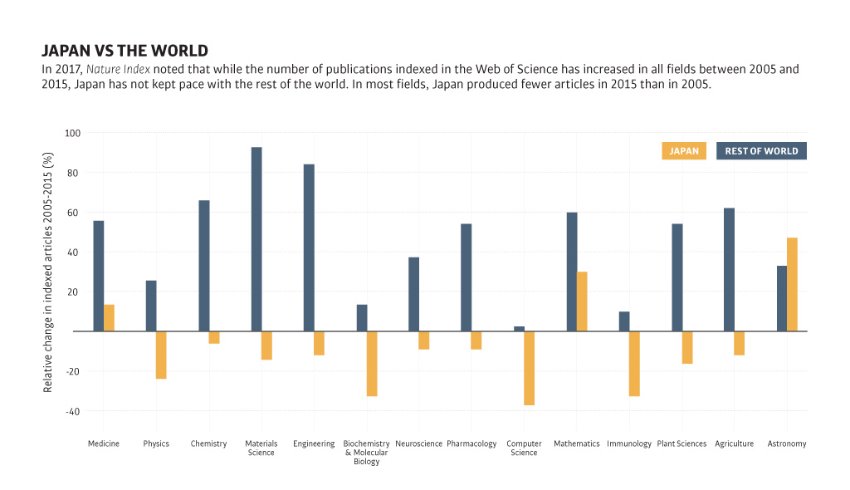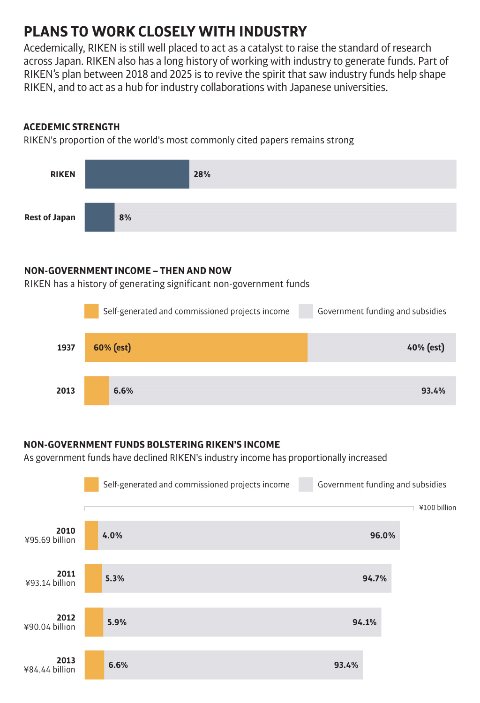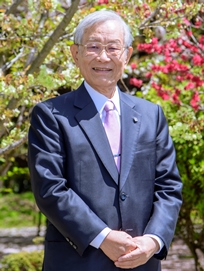Dec. 28, 2017 Perspectives Other
Reforms to confront a national crisis
RIKEN President Hiroshi Matsumoto has a plan to inject fresh life into Japanese science and technology.
In March 2017, Nature published a Nature Index supplement focused on Japan. The front cover depicted a Japanese scientist in a dark room, with the headline ‘Bright sparks needed’. The broad message of the supplement, which was widely covered in the news, was stark: Japanese science and technology, though still in the world’s top tier, is slipping.
For RIKEN, this news comes at an opportune moment. We are preparing our next mid- to long-term plan, for the years 2018 to 2025, and this gives us a chance to put in place reforms that will allow us to play a pivotal role in overcoming this important crisis. I believe the key will be improving the quality of research in Japan, as well as the quality of Japanese researchers. To accomplish this, our reforms will be based around three major objectives.
 JAPAN VS THE WORLD: In 2017, Nature Index noted that while the number of publications indexed in the Web of Science has increased in all fields between 2005 and 2015, Japan has not kept pace with the rest of the world. In most fields, Japan produced fewer articles in 2015 than in 2005. Source: Web of Science
JAPAN VS THE WORLD: In 2017, Nature Index noted that while the number of publications indexed in the Web of Science has increased in all fields between 2005 and 2015, Japan has not kept pace with the rest of the world. In most fields, Japan produced fewer articles in 2015 than in 2005. Source: Web of Science
The first is to develop RIKEN into a science and technology hub. Science in Japan is certainly not in a very robust position today. RIKEN is quite strong academically, with 28 per cent of our papers falling on the top 10 per cent most cited papers in their fields, but across Japan this number is only 8 per cent and that number is falling. While most universities do have individual academic stars, this low average across Japan is troubling. As RIKEN has outperformed the rest of Japan in this respect, it makes sense for us to take the lead in improving scientific research for everyone.
A successful hub will be able to help raise the overall standard of scientific research in Japan. While RIKEN cannot magically make all science in Japan strong again, we can act as a catalyst. At our Science and Technology Hub, for example, RIKEN will act as a focal point for research and will be able to help support collaborations between universities and private companies. We hope that the collaborations established by the hub will lead funds to be funneled to top researchers across Japan, allowing them to make pioneering leaps in knowledge and innovation.We already have a proven track record with this model. Within RIKEN itself, the main Wako campus has, in effect, functioned as the hub for a number of RIKEN’s satellite sites around Japan. This has been quite successful, and we can use our experience to contribute to technological and scientific advances on a national level.
The second objective of our reform program is to develop what we call innovation designers. Typically, scientists focus their energy on the scientific tasks that interest them and are often not aware of all the applications that their work might have for society. I personally believe that scientists should be philosophers as well as researchers, and should always have a vision of the future that they wish to create as they carry out their research. So, of course, I encourage our researchers to have their own dreams and vision. But I also think it is important to have people within an organization like RIKEN who can re-examine the work of individual scientists and look for ways to harness useful advances.
Translating our basic research into innovation is a key to improving our country’s research trajectory. Although the Cluster for Industrial Partnerships at RIKEN works to commercialize our discoveries, its staff are very busy with existing partnerships. As a result, even though many companies know of RIKEN, most do not know how they can work with us.
Currently, we are planning to set up a company that will manage our intellectual property, similar to what has been established at other global research institutions such as Oxford, Cambridge and the Max Planck Society. Eventually, I hope we can re-visit some of the innovation strengths of the RIKEN Konzern—the highly successful network of research and subsidiary companies set up in the early 20th century, which at its peak generated more than half of RIKEN’s income.
 PLANS TO WORK CLOSELY WITH INDUSTRY: Academically, RIKEN is still well placed to act as a catalyst to raise the standard of research across Japan. RIKEN also has a long history of working with industry to generate funds. Part of RIKEN’s plan between 2018 and 2025 is to revive the spirit that saw industry funds help shape RIKEN, and to act as a hub for industry collaborations with Japanese universities. Source: RIKEN Annual Reports 2009-2014
PLANS TO WORK CLOSELY WITH INDUSTRY: Academically, RIKEN is still well placed to act as a catalyst to raise the standard of research across Japan. RIKEN also has a long history of working with industry to generate funds. Part of RIKEN’s plan between 2018 and 2025 is to revive the spirit that saw industry funds help shape RIKEN, and to act as a hub for industry collaborations with Japanese universities. Source: RIKEN Annual Reports 2009-2014
Our third objective is to reform the personnel system, which should help improve the quality of our research and of our researchers. At present, RIKEN’s research personnel are mainly divided into two groups—those working in individual research centers and those working in laboratories run by our chief scientists. The chief-scientist system is unique to RIKEN; it allows laboratories to conduct pioneering research outside the confines of our mission-driven centers.
But there is also a large cultural difference between the two, in that many scientists in chief-scientist laboratories are tenured, while those at the mission-driven centers tend to be on 5- to 10-year fixed-term contracts. For young researchers in particular, this system creates a lack of stability that may hinder their ability to focus on research and deter international researchers from feeling able to take up positions at RIKEN. It is also a terrible waste in that good researchers often leave RIKEN when a center is abolished because they are not tenured. The rise in fixed-term contracts is often discussed as a broad issue hindering Japan’s science and technology research communities, so this problem is not limited to RIKEN.
To redress this, we are now implementing a system under which researchers who have been at RIKEN for some time will be able to apply for tenure, regardless of whether they are at a center or an independent laboratory. Under the new system, someone with this status will be a type of RIKEN employee that has to accept an assignment given to them even if it is in a field of research different from their initial area of study or a position such as a research administrator. In this way, we will set up a system that can hold on to high-quality scientists as the organization changes. One of our presidents, Minoru Oda, compared RIKEN to an amoeba, which could expand amorphously to incorporate new fields. I think this is an interesting idea, but this is only possible when we have outstanding scientists who are able to adapt.
We have also launched a new program for young researchers, called the Hakubi program. A concept taken from China’s Three Kingdoms period (220–280 CE), hakubi refers to an excellent person. The program is about taking risks. We want to hire exceptionally bright and creative individuals in science-related fields and offer them the chance to excel in scientific research. In particular, we want to give strong consideration to people who can bridge the gap between the natural sciences and the humanities.
We are also planning the launch of a new engineering network. Although RIKEN was once heavily devoted to engineering, these days the field only finds a place in a few laboratories. But engineering is very important. The world economy has shifted toward areas such as information technology and finance, where Japan is relatively weak. We need to take the time to rebuild our manufacturing power. So we will bring the remnants of our engineering division together as a network, and once again do research to bolster this area.
Another major change in our next mid-term period involves shifts to adjust to our new status as a Designated National Research and Development Institute. This will mean that RIKEN’s plans and projects will mostly run for seven-year periods rather than five. We will be reorganizing some of our centers under the new plan. We will keep RIKEN Research readers up to date when more information becomes available.
References
About the Researcher
Hiroshi Matsumoto, President

Hiroshi Matsumoto has been president of RIKEN since 2015. He has a doctorate in engineering. His research centered on plasma in the geomagnetosphere and cosmosphere. He is an Honorary Officer of the Most Excellent Order of the British Empire (OBE) and a Chevalier in the French Legion of Honor and has twice been part of a group effort that received a NASA Group Achievement Award.
